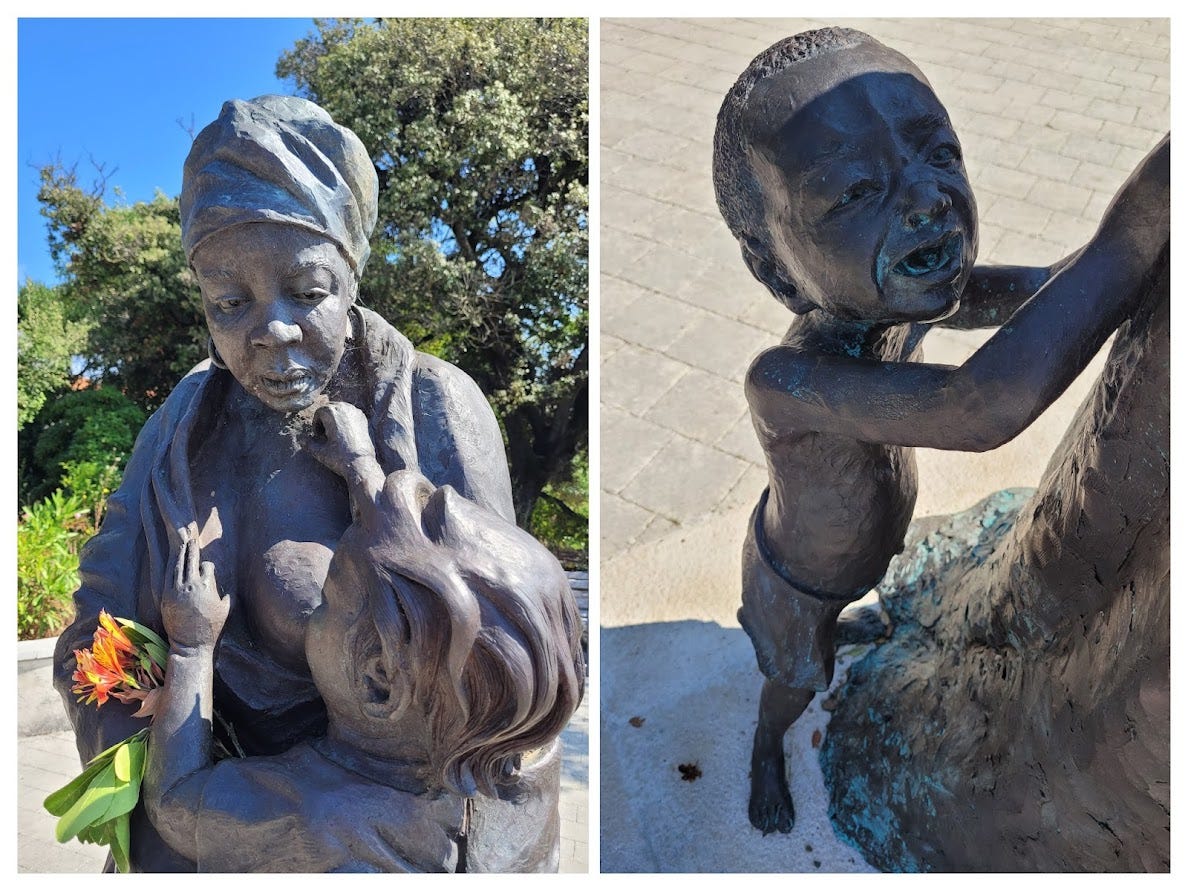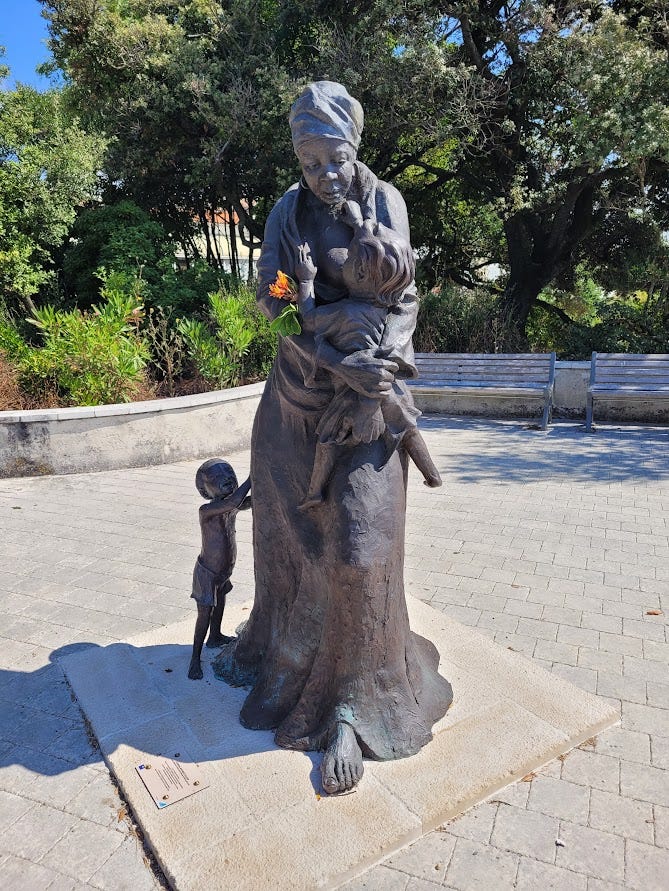La Rochelle : France’s second-biggest slave trade port
There’s a reason for its architectural opulence
Clarisse stands facing the bay, nursing a pudgy-faced baby. An emaciated toddler stands below, tugging at her raggedy ankle-length dress. Her face reflects fatigue and deep resignation: she knows she has no choice but to use her milk to nourish the healthier child, even as her son suffers.
Inaugurated on May 10th 2024 by Prime Minister Gabriel Attal, Clarisse, Nourrice Esclave – Clarisse, the Wet Nurse Slave – is the official name of the statue that forms the centerpiece of a discreet commemorative square.
Sculpted in Bordeaux by the Haitian artist Woodly Caymitte (Filipo) and a team of artisans, the 300-kilo bronze work embodies a clear allegory: white La Rochelle was nourished and enriched by women and men like Clarisse, wrenched from their homes to become mere merchandise in what is euphemistically known as “triangular trade” between Europe, Africa and the Americas.
Unfortunately, Clarisse stands 25 minutes on foot from the town center, “in front of the Casino Barrière”, and is a challenge to find.
A bit of background
Second only to Nantes, La Rochelle was a major French slave trade port, operating for over two centuries: legally from 1594 to 1792, and illegally for decades longer. Over 130,000 Africans were shipped to La Rochelle to be deported to “The New World,” mainly to the French Antilles colonies.
Once there, many carried out their forced labor on sugar plantations in Santo Domingo, now Haiti. The vessels that had imprisoned them in their hold hauled back raw sugar to La Rochelle, where 12 refineries were operating in 1766. By that time, France was supplying half of Europe’s sugar – an extremely lucrative business.
The official town hall website claims that “since 1982, the city has been facing up to its slave-trading past.”
Given this important and inglorious era of La Rochelle’s history, I felt it was incumbent on me to share my impressions of what a visitor can learn about it on-site.
If you go to La Rochelle, do take the time to seek Clarisse out. She conveys much more deeply the slaves’ experience than the entire….
Musée du Nouveau Monde
The city cites the opening of this museum in 1982 as the starting point of its “travail de mémoire” – an impossible-to-translate term that refers to addressing and remembering historical wrongdoing.
Housed in the mansion of a former slave-trading family, les Fleuriau, the artefact-filled museum covers not only the slave trade era, but La Rochelle’s role in France’s colonial efforts in North America, as well as its connection to Native Americans.
The space devoted to “La Rochelle and the French Antilles” contains 5 subsections: La Rochelle, A Port City; The Slave Trade; Colonial Production; Abolitions of Slavery; and The Study.
I was expecting to be rightly distraught by the visit due to the harsh subject matter; I left feeling angry at a haphazard museal experience that lacks gravity and only once truly gives voice to slaves’ experiences:
EXTRACT: “There exists no financial accounting that measures the horror of the slave trade and the abomination of slavery. The navigators’ ledgers…ignore the terror in the depths of the hold. They erase the death rattles of slaves thrown overboard. They negate the rapes of terrified adolescents.”
The text, from French minister Christiane Taubira’s speech proclaiming the 2001 Taubira law recognizing slavery as a crime against humanity, is awkwardly hung on a narrow landing just before the “French Antilles” wing, thus easily missed.
Legends that follow too often use tepid language: conditions on sugar plantations were “often very hard”; Fleuriau’s plantation’s “’movable property’ included 311 slaves, 51 heads of livestock, 12 horses…”
Objects that would bear further context are often most simply labelled:
In the stunningly tone-deaf description of the final exhibit, “Le Cabinet de Travail,” or The Study, no mention whatsoever is made of slavery. Visitors are simply informed that they are “lucky to have the original wall decorations ….Here, we can imagine Aimé-Benjamin Fleuriau examining a report from his steward about the plantation in Bellevue, Santo Domingo. The sugarcane plantation made his fortune…”
On his desk lie the very ledgers Taubira was referring to.
The ledgers of unspeakable crimes.
La Rochelle is currently renovating its Musée de Beaux-Arts. I hope Le Musée du Nouveau Monde is next on the list, not necessarily for renovation, but for a total museal makeover more adapted to the 21st century.
Because what can one even say about a museum that uses this as its children’s logo?
Other efforts
The city of La Rochelle is actively involved in various projects as part of its “travail de mémoire”:
La Rochelle was a founding member of the Fondation pour la Mémoire de l’Esclavage
It maintains cooperation and links with Haiti
The city’s website provides resources and documents about the slave trade, including a link to this excellent online exhibition (in French) hosted by the departmental archives
It has undergone a project of providing extra information on street signs that contain names with a connection to the slave trade.
In 34 years, I’ve rarely heard a French person talk about slavery as anything but a purely US phenomenon. But its abolition in French colonies actually took over 50 years, and was not achieved until 1848.










Thank you for the information,
the reminder of the global extent of the slave trade, and your candid opinioms. As noted below - not the only French example of amnesia about the past. It is important to appreciate that there is more to France than la vie en rose, and that its enviable and undeniable beauty hides some uncomfortable truths. I really appreciated this post.
Ah, yes, France's dirty secret. Not only France's, of course. Many European countries were involved in the trans-Atlantic slave trade, even innocuous-seeming little Denmark. What we know and love as the US Virgin Islands were first the Danish Virgin Islands, after all. It's good that this museum exists in La Rochelle, but by your description it does seem to need some work.